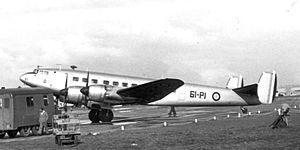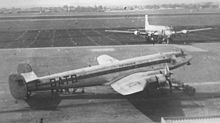Sud-Est SE.161
| Sud-Est SE.161 Languedoc | |
|---|---|

|
|
| Type: | Airliner |
| Design country: | |
| Manufacturer: | |
| First flight: |
September 27, 1939 |
| Production time: |
1946 to 1949 |
| Number of pieces: |
100 |
The Sud-Est SE.161 Languedoc was a four-engine airliner produced by the French manufacturer SNCASE . The original name was Bloch MB.161 . The machine used on short and medium-haul routes was designed for five crew members and 33 passengers. Some of the aircraft delivered to the French military were used as long-range bombers.
The prototype was made before the Second World War . The series machines were delivered from 1946 onwards. Production in Toulouse ended in 1949 after 100 units had been built.
history
After the Société des Avions Marcel Bloch developed the Bloch MB.160 designed for twelve passengers in the mid-1930s , the company designed an enlarged version with more than 30 seats. After the nationalization of the manufacturer, the successor company SNCASE continued the project. The prototype of the MB.161 made its maiden flight in September 1939. At this point in time, Air France had already placed an order for forty machines.
Due to the war, the tests did not end until January 1942. The planned completion of initially twenty aircraft for Air France and Lufthansa was prevented by the delay tactics of the manufacturer.
Only after the liberation of France could a second, improved prototype be completed, which made its first flight on September 27, 1945. Series production of the now SE.161 Languedoc began in 1946. In May 1947, the Polish airline LOT purchased five copies for its European route network and put them into service until October 1947. Other aircraft came into the possession of the French Air Force and Navy.
construction
The SE.161 was an all-metal aircraft designed as a cantilever low- wing aircraft . It had a double vertical tail and a retractable tail wheel landing gear . This turned out to be unreliable and had to be revised several times. The cross-section of the fuselage formed a rounded rectangle.
In addition to five crew members, the Languedoc could accommodate 33 passengers with normal seating. The machines sold abroad by Air France were mainly used on short-haul routes and usually received 44 seats. The aircraft had no pressurized cabin and initially no cabin heating.
The drive initially consisted of four radial engines Gnôme-Rhône 14N 44/45, which were attached to the front of the wings and each made 1150 hp. As they required too much maintenance, they were replaced in 1947 with Pratt & Whitney R-1830 engines fitted with three-bladed propellers . The aircraft used by the French military received Gnôme-Rhône 14R engines and four-blade propellers.
use
The Air France machines were first used on May 28, 1946, initially on the route between Paris and Algiers , later routes within Europe followed. After problems with the drive and the landing gear, the aircraft were parked in October and put back into service from 1947 with new engines and the new designation SE.161.P7. Retrofitting with a de-icing system and cabin heating made it suitable for winter for the first time. From now on it was used on intra-European routes.
After an incident on May 31, 1948, when three of the four engines of the LOT aircraft serial number 21 ( SP-LDA ) failed on the scheduled flight from Warsaw to Paris with a stopover in Strasbourg and forced an emergency landing near Reims , LOT spoke for all of their Languedocs a flight ban. Later she decided not to resume operations because of the lack of foreign currency. On December 20, 1950, all five LOT machines were deleted from the register.
From 1952, Air France only used the unsatisfactory aircraft in freight traffic and finally decommissioned them in 1954. Some of the aircraft were taken over by the French military, and other aircraft were sold abroad. In Spain, Tunisia and Egypt some of them remained in passenger service until 1959.
The machines procured by the French military were given the designation SE.161R. The 25 aircraft taken over by the Navy were used from 1949 to 1959 as long-range transporters and as training machines. The Luftwaffe used their aircraft as transport aircraft until 1955, sometimes as long-range bombers. The Navy had ten aircraft taken over from Air France converted into rescue aircraft.
Some machines later served as test aircraft for engines and guided missiles. The last copy was taken out of service in 1964.
Users
Incidents
During the period in which the Languedoc was deployed, 1947 to 1958 suffered 19 total losses. In 7 of them 102 people were killed. Examples:
- On January 26, 1948, an Air France Languedoc ( aircraft registration F-BCUC ) crashed on a training flight about 8 kilometers south of Le Bourget airport in a furniture factory in the Paris suburb of Romainville . All nine crew members were killed and two factory workers injured.
- On May 31, 1948, three of the four engines of a Sud-Est SE.161 Languedoc of the Polish Polskie line Lotnicze LOT (SP-LDA) failed on the scheduled flight to Paris with a stopover in Strasbourg . The pilot Viktor Pełka managed a field landing at Reims . The inmates were uninjured. The damage to the machine was classified as repairable and repaired in France. However, due to a lack of foreign exchange, LOT did not pick up the plane.
- On December 22, 1951, a Languedoc (SU-AHH) of the Egyptian Misrair crashed 10 kilometers west of Tehran-Mehrabad airport after it had already circled it twice in a snow storm. All 22 people on board were killed.
- On 3 March 1952, a curved Languedoc (F-BCUm) of Air France just after taking off from Nice airport to the left and took a growing inclination one. Eventually she rolled over on her back and crashed about 1 km north of the airport. The cause was determined to be a blocked aileron , which was caused by a jumped control chain on the captain's control column. This structure of the control was found to be a design flaw. All 4 crew members and 34 passengers were killed in this worst accident involving a Languedoc.
- On July 30, 1952, an engine was unnecessarily shut down in a Languedoc of the Egyptian Misrair (SU-AHX) on the flight to Khartoum and the fire extinguisher there was activated. The captain decided to return to the starting point, Cairo-Almaza Airport ( Egypt ). There was also a belly landing which damaged the aircraft beyond repair. All 38 occupants, 5 crew members and 33 passengers survived the crash landing.
- On January 6, 1954, a Languedoc fell (OD ABU) of the Air Liban on the Beirut airport at the start to Kuwait from as a result of engine damage from the runway, the chassis broke down and burnt the machine. All five crew members and four passengers survived.
- On April 24, 1954, the crew of a Languedoc of the Egyptian Misrair (SU-AHZ ) had a warning about an incorrectly extended landing gear when approaching the then international airport of Damascus ( Syria ) . However, the air traffic controller on the tower informed her that the landing gear was extended. After touching down, the right main landing gear collapsed because it was not locked. All 22 occupants, 5 crew members and 17 passengers survived the crash landing. The aircraft was totaled.
- On September 29, 1956, a Languedoc (EC-AKV) of the Spanish Aviaco crashed into a house on a flight from Málaga near Tenerife-Los Rodeos airport . The 38 aircraft occupants survived, but one person was killed on the ground.
- On December 4, 1958, a Languedoc of Aviaco (EC-ANR) crashed on a flight from Vigo to Madrid in the Guadarrama Mountains . All 5 crew members and 16 passengers were killed. The cause is suspected to be strong icing, which led to loss of control.
Technical data (SE.161 Languedoc)
| Parameter | Data |
|---|---|
| crew | 5 |
| Passengers | 33 |
| length | 24.24 m |
| span | 29.38 m |
| height | 5.13 m |
| Wing area | 111.27 m² |
| Wing extension | 7.8 |
| payload | 3,923 kg |
| Empty mass | 12,650 kg |
| Takeoff mass | 22,940 kg |
| Cruising speed | 375 km / h |
| Top speed | 439 km / h |
| Service ceiling | 7,800 m |
| Range | 3,200 km |
| Engines | four radial engines Gnôme-Rhône 14N each with 1150 HP / 845 kW |
Comparable types
See also
literature
- John Stroud: European Transport Aircraft since 1910. Putnam & Company, London 1966, pp. 192–197.
Web links
Individual evidence
- ^ A b Mieczysław Mikulski, Andrzej Glass: Polski transport lotniczy 1918–1978 . Warsaw 1980, p. 400-401 .
- ↑ Accident Statistics SNCASE SE.161 Languedoc , Aviation Safety Network (English), accessed on November 11, 2017.
- ^ Accident report Languedoc F-BCUC , Aviation Safety Network (English), accessed on January 19, 2016.
- ^ Accident report Languedoc SP-LDA , Aviation Safety Network (English), accessed on October 19, 2019.
- ^ Accident report Languedoc SU-AHH , Aviation Safety Network (English), accessed on January 16, 2016.
- ^ Accident report Languedoc F-BCUM , Aviation Safety Network (English), accessed on January 22, 2016.
- ^ Accident report Languedoc SU-AHX , Aviation Safety Network (English), accessed on March 9, 2020.
- ^ Accident report Languedoc OD-ABU , Aviation Safety Network (English), accessed on February 5, 2020.
- ^ Accident report Languedoc SU-AHZ , Aviation Safety Network (English), accessed on March 9, 2020.
- ^ Accident report Languedoc EC-AKV , Aviation Safety Network (English), accessed on January 19, 2016.
- ↑ Air-Britain Archive: Casualty compendium part 68 (English), March 1998, pp. 98/26.
- ^ Accident report Languedoc EC-ANR , Aviation Safety Network (English), accessed on November 11, 2017.

